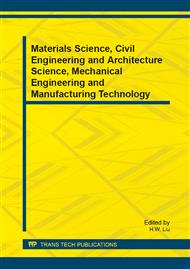[1]
B. Liu (2012). Sentiment Analysis and Opinion Mining. Morgan & Claypool Publishers.
Google Scholar
[2]
A. M. Popescu, B. Nguyen, & O. Etzioni, (2005). OPINE: Extracting product features and opinions from reviews. Presented at the Proceedings of HLT/EMNLP.
DOI: 10.3115/1225733.1225750
Google Scholar
[3]
B. Liu (2011). Web Data Mining. Springer.
Google Scholar
[4]
P. D. Turney, & M. L. Littman (2003). Measuring praise and criticism: Inference of semantic orientation Proceeding.
Google Scholar
[5]
Mingqing Hu, Bing Liu. Mining and summarizing customer reviews. KDD '04, Proceedings of the tenth ACM SIGKDD international conference on Knowledge discovery and data mining from association. ACM Transactions.
DOI: 10.1145/1014052.1014073
Google Scholar
[6]
L Zhang, B. Liu, S. H. Lim, & E O'Brien-Strain. (2010). Extracting and ranking product features in opinion documents. Presented at the Proceedings of the 23rd International Conference on Computational Linguistics: Posters Pages 1462-1.
Google Scholar
[7]
N. Kobayashi, K. Inui, & Y. Matsumoto (2007). Extracting Aspect-Evaluation and Aspect-Of Relations in Opinion Mining. EMNLP-CoNLL.
Google Scholar
[8]
Popescu, A. M., & Etzioni, O. (2007). Extracting product features and opinions from reviews. Natural language processing and text mining.
DOI: 10.1007/978-1-84628-754-1_2
Google Scholar
[9]
G. Qiu , B. Liu, J. Bu, & C. Chen (2009). Expanding Domain Sentiment Lexicon through Double Propagation. IJCAI, (2009).
Google Scholar
[10]
Shi, B., & Chang, K. (2006). Mining Chinese Reviews (p.585–589). Presented at the Sixth IEEE International Conference on Data Mining - Workshops (ICDMW'06).
DOI: 10.1109/icdmw.2006.110
Google Scholar
[11]
C. Yu, (2009). Mining Product Features from Free-Text Customer Reviews: An SVM-Based Approach Presented at the Information Science and Engineering (ICISE), 2009, p.900–903.
DOI: 10.1109/icise.2009.743
Google Scholar
[12]
S. Li, Q. Ye , Y. Li, & R. Law (2009). Journal of Management Sciences in China. In Chinese.
Google Scholar
[13]
S. Li, M. Ji (2011). A DFM model of mining product features from customer reviews. Control.
Google Scholar
[14]
J. Y. Yang, J. Myung, & S. Lee (2009). A holistic approach to product review summarization. Future Dependable Distributed.
DOI: 10.1109/stfssd.2009.11
Google Scholar
[15]
S. Kovelamudi, S. Ramalingam, A. Sood, & V. Varma (2011). Domain Independent Model for Product Attribute Extraction from User Reviews using Wikipedia. IJCNLP.
Google Scholar


